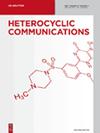Isatin-3-氨基硫脲显色传感器选择性检测氟离子
IF 1.5
3区 化学
Q3 CHEMISTRY, ORGANIC
引用次数: 6
摘要
摘要在本研究中,我们描述了含有两个不同阴离子识别单元,即isatin NH和硫脲部分的isatin-3-氨基硫脲2的阴离子识别能力。两者都有能力充当质子供体。最重要的是,只有在添加F-阴离子后,在有机介质中才观察到2的显著颜色变化(从浅黄色到红橙色)。对于任何其他阴离子,包括Cl–、Br–、I–、H2PO4−、${\text{H}_{2}}\text{P}{\text{O}_}^{-}、$NO2−、$\text{{N}{{\text{O}}_{text{2}}^}-}、$PF4−$\text{。紫外-可见光谱研究也表明了该化合物在选择性检测氟阴离子方面的潜力。1H-NMR滴定清楚地表明了2.F–阴离子络合物的形成。还进行了密度泛函理论(DFT)计算,以进一步了解2.F–络合物的形成。本文章由计算机程序翻译,如有差异,请以英文原文为准。
Isatin-3-thiosemicarbazone as Chromogenic Sensor for the Selective Detection of Fluoride Anion
Abstract In this study, we describe the anion recognition ability of isatin-3-thiosemicarbazone 2, which contains two different anion recognition units i.e. isatin NH and the thiourea moiety. Both have the ability to act as proton donors. Most importantly, a significant colour change of 2 was observed (from light yellow to reddish orange) in organic medium only after the addition of the F– anion. No such colour change could be observed for any other anions including Cl–, Br–, I–, H2PO4−, ${{\text{H}}_{2}}\text{P}{{\text{O}}_{4}}^{-},$ NO2−, $\text{N}{{\text{O}}_{\text{2}}}^{-},$ PF4− $\text{P}{{\text{F}}_{4}}^{-}$etc. The UV-Vis spectroscopic studies also indicate the potential of this compound for selective detection of fluoride anions. 1H-NMR titrations clearly indicate the formation of the 2.F– anionic complex. The Density-functional theory (DFT) calculations are also performed to get further insights on the formation of 2.F– complex.
求助全文
通过发布文献求助,成功后即可免费获取论文全文。
去求助
来源期刊

Heterocyclic Communications
化学-有机化学
CiteScore
3.80
自引率
4.30%
发文量
13
审稿时长
1.4 months
期刊介绍:
Heterocyclic Communications (HC) is a bimonthly, peer-reviewed journal publishing preliminary communications, research articles, and reviews on significant developments in all phases of heterocyclic chemistry, including general synthesis, natural products, computational analysis, considerable biological activity and inorganic ring systems. Clear presentation of experimental and computational data is strongly emphasized. Heterocyclic chemistry is a rapidly growing field. By some estimates original research papers in heterocyclic chemistry have increased to more than 60% of the current organic chemistry literature published. This explosive growth is even greater when considering heterocyclic research published in materials science, physical, biophysical, analytical, bioorganic, pharmaceutical, medicinal and natural products journals. There is a need, therefore, for a journal dedicated explicitly to heterocyclic chemistry and the properties of heterocyclic compounds.
 求助内容:
求助内容: 应助结果提醒方式:
应助结果提醒方式:


